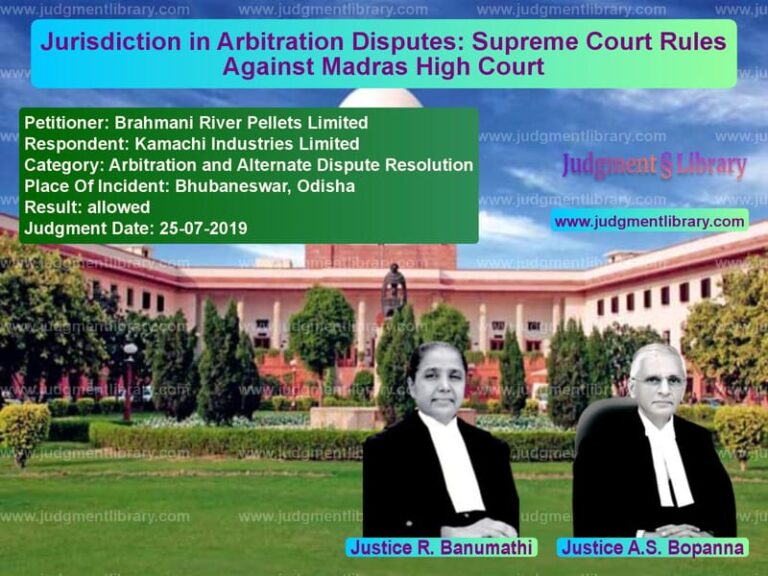Murder Conviction Overturned: Supreme Court Acquits Death Row Convicts Due to Lack of Evidence
The case of Digamber Vaishnav & Anr. v. State of Chhattisgarh revolves around the conviction and death sentence of two individuals accused of multiple murders. The Supreme Court, in its judgment dated March 5, 2019, overturned the death sentence imposed by the lower courts, citing lack of concrete evidence and inconsistencies in witness testimonies.
This judgment is significant as it reinforces the principle that suspicion, however strong, cannot replace legal proof in criminal cases.
Case Background
The appellants, Digamber Vaishnav and Girdhari Vaishnav, were convicted for the murder of five women in a house in Khapridih village, Chhattisgarh. The prosecution alleged that the accused had entered the house on December 17, 2012, committed robbery, and strangled the victims.
Key facts of the case:
- The victims were found dead in the house with signs of strangulation.
- A bottle of liquor, a torch, and some strands of hair were recovered from the crime scene.
- The accused were arrested based on circumstantial evidence, including recovery of cash and silver jewelry.
- The trial court sentenced both accused to death on May 14, 2014.
- The Chhattisgarh High Court confirmed the death sentence on April 30, 2015.
The accused then approached the Supreme Court, challenging their conviction and sentence.
Petitioners’ Arguments
The appellants, represented by Senior Advocate S. Nagamuthu, contended:
- The prosecution relied entirely on circumstantial evidence.
- The child witness (PW-8) was not an eyewitness to the crime and had given inconsistent statements.
- The forensic evidence, including hair analysis and fingerprint reports, was inconclusive.
- The recovery of cash and jewelry was unconnected to the alleged robbery.
- The prosecution failed to establish motive beyond reasonable doubt.
Respondent’s Arguments
The State of Chhattisgarh, represented by Advocate Atul Jha, countered:
- The chain of circumstantial evidence was strong enough to prove guilt.
- The accused were last seen in the vicinity of the crime scene.
- The forensic evidence, though not conclusive, corroborated other circumstances.
- The High Court had correctly upheld the trial court’s findings.
Supreme Court’s Observations and Ruling
The Supreme Court found serious lapses in the prosecution’s case, emphasizing that:
“The burden of proof squarely rests on the prosecution, and there can be no conviction based on surmises, conjectures, or suspicion, however grave.”
Regarding the testimony of the child witness (PW-8), the Court noted:
“The evidence of a child witness must be evaluated carefully, as they are susceptible to influence. In this case, PW-8 did not directly witness the crime and gave inconsistent statements.”
On forensic evidence:
“The fingerprint and hair analysis reports were inconclusive and failed to directly link the accused to the crime scene.”
On circumstantial evidence:
“The prosecution failed to establish an unbroken chain of circumstances that pointed only to the guilt of the accused and excluded every other possibility.”
The Court also pointed out inconsistencies in witness testimonies:
“The prosecution’s witnesses contradicted each other on key points, including the timeline of events and identification of the accused.”
As a result, the Supreme Court:
- Set aside the conviction and death sentence.
- Acquitted the accused of all charges.
- Ordered their immediate release.
Conclusion
This judgment underscores the fundamental principle that criminal convictions must be based on clear and convincing evidence. The key takeaways from this ruling are:
- Circumstantial evidence must form a complete chain that excludes all possibilities except guilt.
- Testimonies of child witnesses must be carefully scrutinized for reliability.
- Forensic evidence must be conclusive to support a conviction.
- Death penalty cases require the highest standard of proof.
By acquitting the appellants, the Supreme Court reaffirmed the principle that justice must be based on proof beyond a reasonable doubt and that suspicion, however strong, cannot replace evidence.
Petitioner Name: Digamber Vaishnav & Anr..Respondent Name: State of Chhattisgarh.Judgment By: Justice A.K. Sikri, Justice S. Abdul Nazeer, Justice M.R. Shah.Place Of Incident: Khapridih village, Chhattisgarh.Judgment Date: 05-03-2019.
Don’t miss out on the full details! Download the complete judgment in PDF format below and gain valuable insights instantly!
Download Judgment: Digamber Vaishnav & vs State of Chhattisgar Supreme Court of India Judgment Dated 05-03-2019.pdf
Direct Downlaod Judgment: Direct downlaod this Judgment
See all petitions in Murder Cases
See all petitions in Bail and Anticipatory Bail
See all petitions in Custodial Deaths and Police Misconduct
See all petitions in Judgment by A.K. Sikri
See all petitions in Judgment by S. Abdul Nazeer
See all petitions in Judgment by Mukeshkumar Rasikbhai Shah
See all petitions in allowed
See all petitions in Quashed
See all petitions in supreme court of India judgments March 2019
See all petitions in 2019 judgments
See all posts in Criminal Cases Category
See all allowed petitions in Criminal Cases Category
See all Dismissed petitions in Criminal Cases Category
See all partially allowed petitions in Criminal Cases Category







